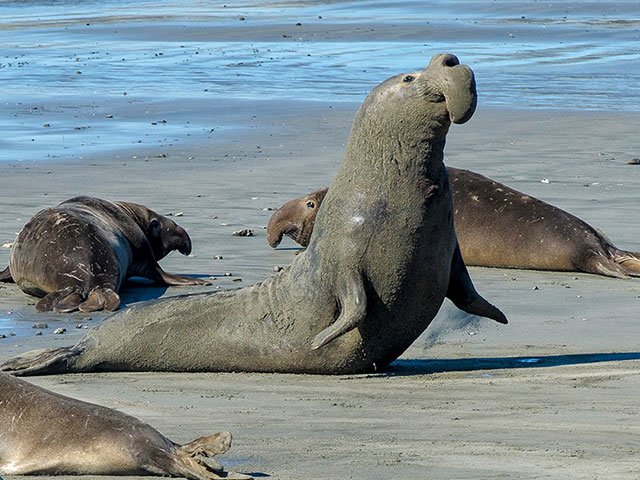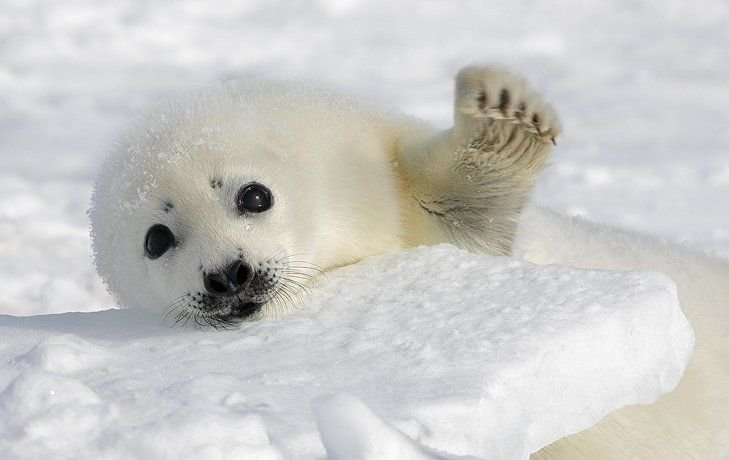For some reason, seals always fascinate me. I think it must be because they are carnivores with a difference. While carnivores usually live on land, seals live in the water and only comes to dry land to rest and breed. There are some seals that actually mate in water but even so, the females have to come on land to give birth to their young, which are called pups.
When seals come out on land in larger numbers to mate and to give birth, those place where they do so are called rookeries.
Millions of years ago the ancestors of seals lived on land. Then they took to living in water. This meant that their bodies had to undergo many changes. Their limbs changed from legs to flippers and they lost their tails – only a stump of it now remains. As they changed to living in water, their diet changed, too. They started eating fish and other water animals, such as squid, octopus and shellfish.
Seals are divided into three families: the earless seals, eared seals and walruses. But even the eared seals have only tiny ear flaps.
The earless seals:
Earless seals are also called true seals or hair seals. The smallest of them is the one known in Britain as the common seal and in North America as the harbour seal. It is about 2m long. The largest is the sea elephant or elephant seal, which lives in Antarctic waters. The male elephant seal is about 6,5m long and weighs 2 tonnes. True seals have a harsh dark fur but, with the exception of the harbour seal, which is born with the adult coat, their pups have pale woolly coats.
Eared seals:
There are two kinds of eared seals: the sea lions and the fur seals. One way in which they differ from true seals is that they can bring their hind flippers forward, to use them for walking on land. The true seals cannot do this and can only move clumsily when on land. The fur seals used to be killed in large numbers when sealskin fur coats were fashionable.
Walruses:
Walruses are found only in Arctic seas. They used to haul out, as the saying goes, onto beaches, like other seals. Now, because so many were killed for their ivory tusks, their oil and their flesh, they haul out mainly on icefloes.
Male walruses may be 4m long and weigh about 1 tonne. The females are only 2,5m long. A walrus’ skin is wrinkled and has only short fur. As it grows older it loses most of its fur, so that its skin is more or less naked.
What makes a walrus different from other seals is its long tusks. These are long canine teeth that hang down from the upper jaw. The tusks are made of a kind of ivory. Walruses eat mainly clams and crabs. It used to be said that they used their tusks for digging up the seabed in search for food. It is now known this is not so, but no one knows what purpose the tusks do serve.
Sealions are found on the Pacific coasts of North and South America, on the coasts of Australia, the Auckland Islands (south of New Zealand) and Japan. They, and the fur seals, are known as eared seals. But their ears are very small:

The largest of all seals is the elephant seal. It was given this name not so much for its size as for the long drooping nose of the male. A bull elephant seal may be nearly 7m long and weigh more than 2 tonnes. The female or cow is only half the size of the bull. Elephant seals belong to the group of seals known as the earless seals:

A baby harp seal on an icefloe in the North Atlantic. The attractive fur of these baby seals has led to them being widely hunted, although the increasing awareness of conservation is helping to reduce the hunting:

Walruses live in the Arctic regions of both the Atlantic and the Pacific Oceans. They form the third family of seals and they, too, are earless. Both males and females have a pair of large tusks.

Check out this cool video about Harbour seals!
The following video shows two Elephant seals battling to find the 'alpha male':
YouTube
Resources and Extra reading:
Seals | Pinniped | Earless seals | Eared seals | Walrus | Elephant seal | Sealion | Harp seal

Nice post
They are huge and somewhat dangerously beautiful
Lesson learnt: adaptation is key to the survival of any specie. Perhaps the million of years ago when seals use to live on land the conditions were favourable to them, but as the ecosystem changes, they had to adapt to their new environment. Many specie might have been lost which couldn't adapt. This scenario I would relate to the present regime of climate change,if proactive steps are not taking,many species will be lost and maybe even humans will have to live in water as aquatic..lol
Thanks for the great post and info